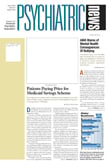Hollywood continues to be fascinated with psychiatric themes. At least 10 movies that featured different kinds of relationships between therapists and patients were box-office hits in the 1990s, said Maj. Steven Pflanz, a psychiatrist who led a workshop on psychiatry and film at APA’s 2002 annual meeting in May in Philadelphia.
Among these films were “Good Will Hunting,” “Analyze This,” “As Good as It Gets,” “Don Juan DeMarco,” and “Grosse Pointe Blank.”
“Psychotherapy appeals to filmmakers because it deals with powerful human emotions, and art is really about human emotions at its core,” said Pflanz, who has presented numerous workshops at previous annual meetings.
Pflanz is chief of mental health services and deputy squadron commander of the 90th Medical Operations Squadron at F.E. Warren Air Force Base in Cheyenne, Wyo.
But when does artistic license cross the line and become an irresponsible misrepresentation? The answer is not always clear.
For example, in the 1997 movie “Good Will Hunting,” Robin Williams plays psychotherapist Shawn McGuire, who helps Will Hunting, a troubled math genius, come to terms with his abusive past. Pflanz and others at the workshop characterized the therapeutic relationship as a positive one that “transformed the patient and therapist.”
However, the movie also includes a scene early in Will’s therapy in which he insults McGuire’s wife. McGuire responds by pushing Will against the wall and threatening to hit him if he ever again insults his wife, who is deceased. Later in the film, there are scenes of McGuire hugging Will and visiting each other at home.
“We are supposed to be the agency of compassion,” said one psychiatrist who attended the session. “People seeing a therapist assault a patient might wonder if that would happen in therapy and feel unsafe.”
Another audience member said, “Hugging a patient and visiting the patient in his home is clearly a line that many therapists would not cross.”
In the 1999 movie “Analyze This,” Robert de Niro plays a Mafia boss who consults a psychiatrist, played by Billy Crystal, to help him deal with his emotional problems. To avoid being “whacked by the mob” for revealing secrets to a psychiatrist, de Niro insists on clandestine meetings with the psychiatrist, including impromptu visits while the psychiatrist is on vacation and at the psychiatrist’s home after breaking in.
Crystal’s character “seemed weak and intimidated by de Niro,” commented an audience member. “There were numerous violations of professional boundaries,” said another.
By contrast, the 1997 film “As Good as It Gets” got high marks from the workshop audience for depicting the psychiatrist in the movie as a professional who set boundaries with patients and providing a more realistic portrayal of how psychiatry is practiced.
In one scene, for example, Melvin Udall, played by Jack Nicholson, barges into the psychiatrist’s office without an appointment and clearly expects to be seen immediately. The psychiatrist patiently but firmly explains to Udall that he will not make an exception for him and instead schedules an appointment.
Hollywood movies tend to portray women therapists in more compromising roles than men, said Pflanz. As of 1989, there were twice as many films portraying unethical sexual behavior by women therapists as male therapists, according to the 1999 book Psychiatry and the Cinema by Gabbard and Gabbard (American Psychiatric Press Inc., 1999).
That pattern continued in the 1990s with such movies as “The Prince of Tides.” Barbra Streisand plays a psychiatrist who becomes romantically involved with the brother of a suicidal patient. The brother is played by Nick Nolte.
Portrayals of psychotherapists as dark characters who murder their patients in movies such as “Dressed to Kill” and “Whispers in the Dark” are examples of art misrepresenting psychotherapy, said Pflanz.
“We should let producers know when they portray the profession in a responsible manner and when they don’t. We should also educate them about the profession so they have a better understanding of psychotherapy,” said Pflanz. ▪

